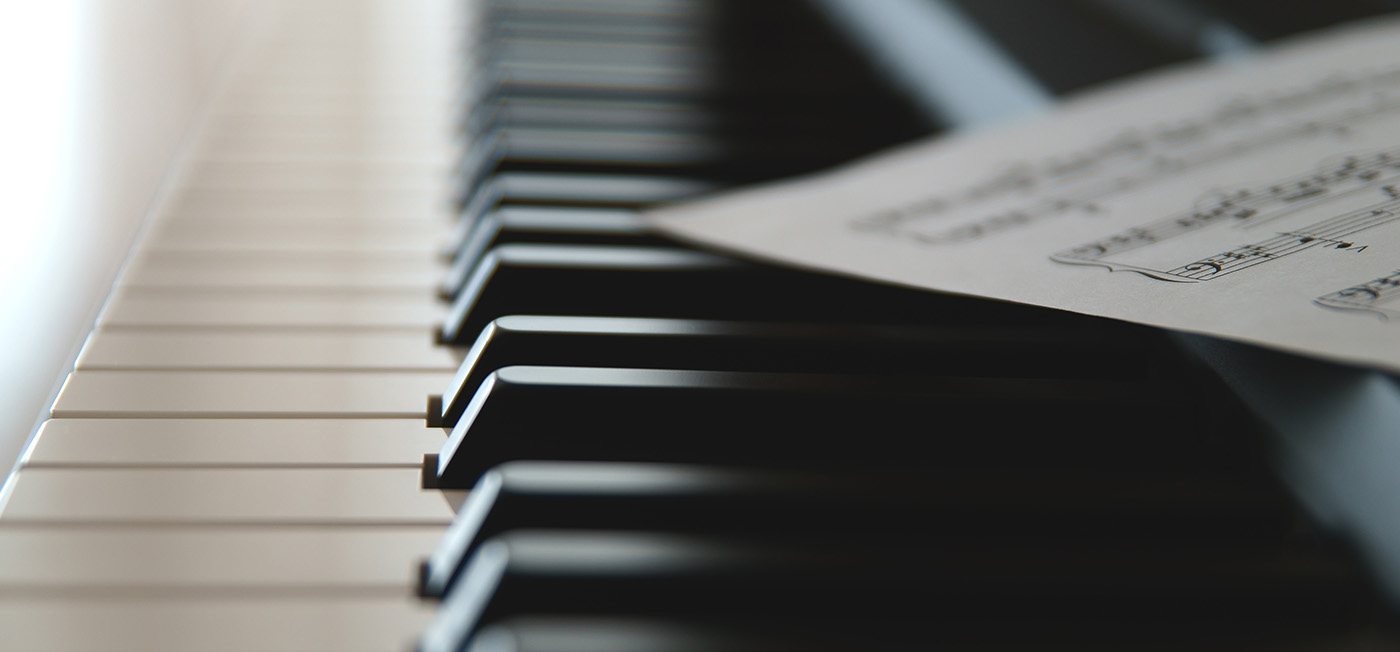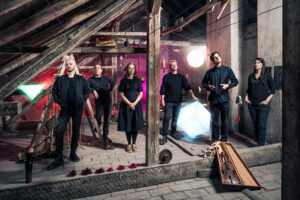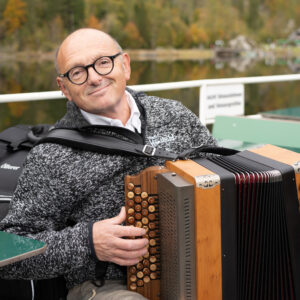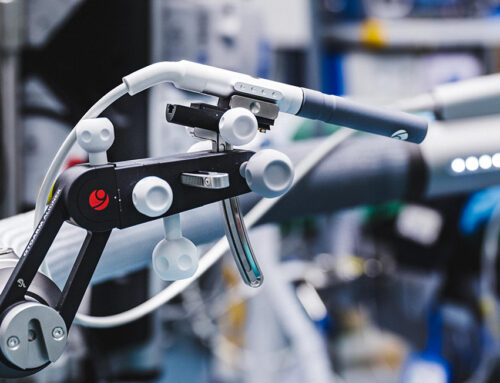Five features of a CI system for listening to music with a cochlear implant
With cochlear implants, hearing is different. But what key factors make it possible to enjoy music with CI in good sound quality?
Eva Kohl

The sound of a black key and the adjacent white key on the piano differs by exactly one semitone. Can you hear a semitone like that? Do you hear whether music is played in major or minor keyis ? These so-called "modes (major and minor)", which are familiar to us, differ only in three places by a semitone. Many people in our Western culture intuitively feel that major music is cheerful, whereas minor is melancholic.1 In order to consciously perceive a semitone audibly, practice is required – for normal hearing people as well as for users of cochlear implants, in short: CIs.

The bilateral CI user and professional musician Laura Korhonen (centre) regularly stands on stage with her group SATUO, in addition to giving music and dance lessons. Click here for an audio interview with Finnish-born Laura Korhonen: https://youtu.be/v-NKg8xYYus ©mattobserve.com
The right cochlear implant for music
1. The length of the electrode
The acoustics of music pose greater challenges to hearing systems than to language: think of the deep sound of a tuba, which is significantly deeper than any human voice, while the highest child’s voice does not reach the pitch of the piccolo flute. Spoken language ranges from about 125 hertz to 8000 hertz.2 Instrumental music even starts at just over 30 hertz.3
To reproduce this wide frequency range as faithfully as possible, the electrode array of the cochlear implant should cover the cochlea as much as possible. However, cochlear length varies, typically ranging between 28 and 34 millimeters. Even users with shorter electrode arrays can, in principle, hear all sounds — the sound spectrum is simply compressed to fit the shorter electrode. It is therefore understandable that it may take some time for users to adapt to the altered sound quality.4
MED-EL, the Austrian CI manufacturer, is the only company to offer electrode arrays of such length. Its extensive portfolio also includes shorter arrays designed for unusually small cochleae. With the unique OTOPLAN planning software, surgeons can determine the ideal electrode length even before surgery. This gives CI users access to the entire frequency spectrum — including the low tones perceived at the apex of the cochlea — resulting in a noticeably enhanced musical experience.5
2. Anatomically correct fitting
While the authors of a 2025 study6 critically reflected on some of their own findings, their data clearly showed one thing: “Participants experienced improvements in music perception with the image-guided cochlear implant programming strategy.” Specifically, they were able to recognize melodies better.
The previously mentioned OTOPLAN software also plays a key role here: after implantation, it can display the exact position of each individual electrode contact and indicate which pitch would naturally be perceived at that location in the cochlea. The CI technician or speech therapist then adjusts the frequency mapping of the CI system accordingly — an anatomically based fitting for even more natural sound experience.
3. Fine structure coding
Timbre, the quality that allows us to distinguish between different instruments, plays a crucial role in how we perceive sound. Most cochlear implant technologies use only slower temporal aspects of the signal, known as the envelope, in their coding strategies. Pitch is conveyed solely through the position of the electrode contact within the cochlea.
MED-EL’s FineHearing technology goes a step further by incorporating frequency-matched coding to stimulate low-frequency sounds in sync with the fine structure of the signal. This combination of place-based and frequency-based coding enhances the perception of timbre and brings users closer to natural hearing. 7
We can compare this to a DJ mixing console: when music is played faster, it doesn’t just speed up — it also sounds higher in pitch. For accurate pitch perception, especially of low-frequency sounds, a CI system must slow down the stimulation so that it matches the vibration frequency of the tone.8 9 10 11
4. Additional channels through Intelligent Parallel Stimulation
For understanding speech in quiet environments, only a few transmitted frequency ranges may be sufficient. Comprehending speech in background noise, however, is more demanding. Music, in turn, forms a complex tapestry of layered sounds that requires the transmission of far more frequency channels.
In earlier CI systems, the number of available channels corresponded to the number of electrode contacts or contact pairs on the array. This number is limited, since contacts placed too closely together can interfere with one another. MED-EL, by contrast, uses its unique Intelligent Parallel Stimulation to simulate up to 250 distinct pitch percepts — delivering a richer and more natural sound experience.
5. Wide dynamic range of volume
The volume of a piece of music ranges from piano pianissimo to forte fortissimo, with fortissimo in an orchestra reaching truly powerful levels. To reproduce this range with cochlear implant systems, a front-end processing design with a wide dynamic range is essential, along with music programs specifically developed for optimal compression. Only then can CI users perceive the dynamic complexity of music without excessive distortion of loudness modulation.12

CI user and folk musician Heinz Kirchschlager: "Music is especially important for me!" Here you can find more information about CI user and hearing consultant Heinz Kirchschlager: https://www.hoerverlust.at/berater/heinz/" ©Max Breynck
Cochlear implants as a music receiver
When these conditions are met, modern CI systems enable users to perceive not only speech but also the more complex sounds of music with remarkable fidelity. Structured music training can further enhance these outcomes.13
In earlier studies, users of older CI systems were typically able to detect pitch differences of at least three semitones. However, a scientific study accompanying the MELUDIA14 music training program shows that today, 80 percent of MED-EL users can successfully complete lessons distinguishing even single semitones.15 This is also reflected in the many music enthusiasts, amateur musicians, and even professional performers who use cochlear implants.
[1] On other continents, this is sometimes felt differently
[2] https://blog.medel.pro/audiology/cochlear-implants-and-music/
[3] Music and Cochlear Implants - MED-EL Professionals Blog; https://sound-au.com/articles/fadb.htm, 2.5.2025 11:56; Auditory perception and cognitive performance, in: Helmet-mounted displays: Sensation, perception and cognition issues, p.391-490, C.E. Rash, M.B. Russo, T.R. Letowski, E.T. Schmeisser, U.S. Army Aeromedical Research Laboratory, 2009, DOI:10.13140/2.1.3160.1925
[4] Landwehr et al. Effects of various electrode configurations on music perception, intonation and speaker gender identification. Cochlear Implants Int. 2014 Jan; 15(1): 27-35.
[5] Müller et al. Clinical trial results with the MED-EL fine structure processing coding strategy in experienced cochlear implant users. ORL J Otorhinolaryngol Relat Spec. 2012; 74(4): 185-98.
[6] Schatzer, R. et al. (2014) Electric-acoustic pitch comparisons in single-sided-deaf cochlear implant users: frequency-place functions and rate pitch. Hear Res., 309, 26-35.
[7] Rader, T. et al. (2016). Place dependent stimulation rates improve pitch perception in cochlear implants with single-sided deficiency. Hear Res., 339, pp. 94-103.
[8] Landsberger, D.M. et al. (2016). Qualities of single electrode stimulation as a function of rate and place of stimulation with a cochlear implant. Ear Hear., 37(3), 149-159.
[9] Prentiss, S., Staecker, H., & Wolford, B. (2014). Ipsilateral acoustic electric pitch matching: a case study of cochlear implantation in an up-sloping hearing loss with preserved hearing across multiple frequencies. Cochlear Implants Int., 15(3), 161-165.
[10] Gilbert, M. et al. (2021). Cochlear Implant Compression Optimisation for Musical Sound Quality in MED-EL Users. Ear And Hearing, 43(3), 862-873. https://doi.org/10.1097/aud.0000000000001145
[11] Kang, R. et al., 2009. Development and validation of the University of Washington clinical assessment of music perception test. Ear & Hearing, 30(4): 411-418. doi: https://doi.org/10.1097/AUD.0b013e3181a61bc0.
[12] Meludia.com, free access for users of MED-EL CIs via myMEDEL
[13] Boyer J, Stohl J. MELUDIA - Online music training for cochlear implant users. Cochlear Implants Int. 2022 Sep;23(5):257-269. doi: 10.1080/14670100.2022.2069313. Epub 2022 May 9. PMID: 35534440.






